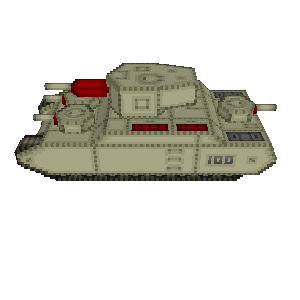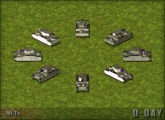Difference between revisions of "Shisei 100t"
From D-day: wiki
m (Mig Eater moved page Mi-To to Shisei 100t: name clarification) |
|||
| (7 intermediate revisions by the same user not shown) | |||
| Line 1: | Line 1: | ||
| + | <noinclude> | ||
{{Unitinfo | {{Unitinfo | ||
| image=[[File:mi_to_3d.gif|300px|Mi-To]] | | image=[[File:mi_to_3d.gif|300px|Mi-To]] | ||
| Line 20: | Line 21: | ||
| − | Mainly know as the "100 Ton Tank" the only surviving documents of this project are on display at the Wakajishi shrine museum along with a single track link. The name Mi-To comes from post-war interviews with engineers working on the project who nicknamed it the Mitsubishi-Tokyo or Mi-To tank for short, they also state that a prototype was built but failed miserably and was | + | Mainly know as the "100 Ton Tank" the only surviving documents of this project are on display at the Wakajishi shrine museum along with a single track link. The name Mi-To comes from post-war interviews with engineers working on the project who nicknamed it the Mitsubishi-Tokyo or Mi-To tank for short, they also state that a prototype was built but failed miserably and was later scrapped, the piece of track at Wakajishi shrine being the only thing left. |
==References== | ==References== | ||
*[http://ftr.wot-news.com/2013/11/19/superheavy-japanese-tanks/ For The Record] | *[http://ftr.wot-news.com/2013/11/19/superheavy-japanese-tanks/ For The Record] | ||
| + | }} | ||
| + | |||
| + | |||
| + | {{Timeframe | ||
| + | |||
| + | |earlywar=yes | ||
| + | |totalwar=yes | ||
| + | |||
| + | |earlybc=yes | ||
| + | |midbc=yes | ||
| + | |latebc=yes | ||
| + | |postbc=yes | ||
| + | |totalbc=yes | ||
| + | |||
}} | }} | ||
| Line 32: | Line 47: | ||
|content= | |content= | ||
image:mi_to.jpg{{!}} | image:mi_to.jpg{{!}} | ||
| + | image:mi_to_01.jpg{{!}} | ||
}} | }} | ||
| + | |||
| + | |||
| + | {{Box | ||
| + | |title=Comments | ||
| + | |content= | ||
| + | |||
| + | <comments voting="Plus" /> | ||
| + | |||
| + | }} | ||
| + | |||
{{JapanNav}} | {{JapanNav}} | ||
| + | |||
| + | </noinclude> | ||
| + | <includeonly> | ||
| + | ==[[Mi-To]]== | ||
| + | <table> | ||
| + | <tr> | ||
| + | <td> | ||
| + | Mainly know as the "100 Ton Tank" the only surviving documents of this project are on display at the Wakajishi shrine museum along with a single track link. The name Mi-To comes from post-war interviews with engineers working on the project who nicknamed it the Mitsubishi-Tokyo or Mi-To tank for short, they also state that a prototype was built but failed miserably and was later scrapped, the piece of track at Wakajishi shrine being the only thing left. | ||
| + | </td> | ||
| + | <td width="300"> | ||
| + | [[File:mi_to_3d.gif|300px|Mi-To]] | ||
| + | </td> | ||
| + | </tr> | ||
| + | </table> | ||
| + | </includeonly> | ||
Latest revision as of 07:37, 10 April 2015
| ||||||||||||||||
History
Mainly know as the "100 Ton Tank" the only surviving documents of this project are on display at the Wakajishi shrine museum along with a single track link. The name Mi-To comes from post-war interviews with engineers working on the project who nicknamed it the Mitsubishi-Tokyo or Mi-To tank for short, they also state that a prototype was built but failed miserably and was later scrapped, the piece of track at Wakajishi shrine being the only thing left.
References
. . . .
Time Frames
| 1930 - 1940: Pre-War |
1940 - 1942: Early-War |
1942 - 1944: Mid-War |
1944 - 1945: Late-War |
1945 - 1960: Post-War |
1930 - 1960: Total-War |
|
| Buildable | Yes | Yes | ||||
| Bonus Crate | Yes | Yes | Yes | Yes | Yes |
. . . .
Comments
. . . .



Enable comment auto-refresher